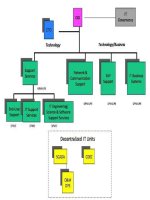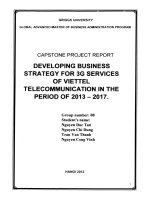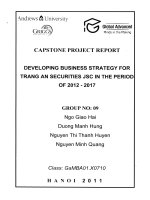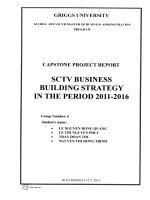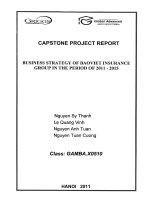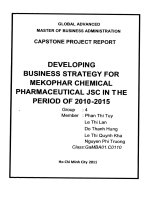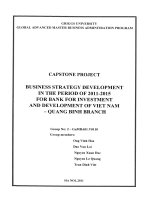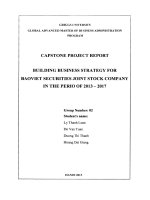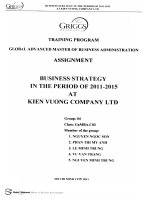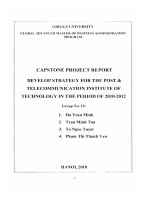Build business strategy in the period of 2011-2015 for Military Commercial Joint Stock Bank- Dien Bien Phu Branch
Bạn đang xem bản rút gọn của tài liệu. Xem và tải ngay bản đầy đủ của tài liệu tại đây (1.16 MB, 98 trang )
1
GRIGGS UNIVERSITY
GLOBAL ADVANCED MASTER OF BUSSINESS ADMINISTRATION
PROGRAMS
CAPSTONE PROJECT REPORT
“Build business strategy in the
period of 2011-2015 for Military
Commercial Joint Stock Bank
- Dien Bien Phu Branch”
Group Number: 01
Nguyen Ngoc An
Do Thi Ha
Hoang Thi Thu Hien
Nguyen Minh Hung
Pham Thi Huong
HA NOI 2011
i
COMMITMENT
We here by commit: The capstone‟s content is our actual research, which has
been implemented on the basis of theoretical research, real situation of the bank.
Data and figures of the capstone are true. Given strategies and solutions start from
our practice and experience.
Once again, we confirm the truthfulness of the above commitment!
ii
ACKNOWLEDGEMENT
We faithfully thank all teachers of the program. In order to complete this
graduate program and capstone, we have received wholehearted and enthusiastic
guidance, assistance and criticisms of all teachers.
Thank the Management Bank of Military Commercial Joint Stock Bank,
Dien Bien Phu Branch and colleagues who have wholeheartedly exchanged views,
offered suggestions and provided data and figure.
iii
TABLE OF CONTENTS
CONTENTS
Page
Commitment
i
Acknowledgement
ii
Table of content
iii
List of tables and figures
vi
List of appendices
viii
List of abbreviations
ix
INTRODUCTION
1
CHAPTER 1: GENERAL THEORETICAL FOUNDATIONS OF
BUILDING BUSINESS STRATEGY
4
1.1 Theories of strategy and strategic management
4
1.1.1. Concept of strategy
4
1.1.2 Bases of strategy
6
1.1.3 Basic steps of strategic management
7
1.1.3.1 Stage of planning strategy
8
1.1.3.2 Stage of implementing and inspecting strategy
10
1.2 Analysis of environmental factors
12
1.2.1. Analysis of macro environment – PEST Model
12
1.2.1.1.Politics
13
1.2.1.2 Economics
14
1.2.1.3. Socioculture
14
1.2.1.4. Technology
15
iv
1.2.1.5. Integration
15
1.2.2 Analysis of the environment of sectors - Micheal Porter‟s Five
Forces Model
16
1.2.2.1. Competitive pressures from the suppliers
17
1.2.2.2. Competitive pressures from customers
17
1.2.2.3. Competitive pressures from potential competitors
18
1.2.2.4. Competitive pressures from substitute products
18
1.2.2.5. Competitive pressures in the internal
18
1.2.3 Analysis of the internal environment
18
1.3 Establishment of SWOT matrix and selection of business strategy
20
CHAPTER 2: ANALYSIS OF ENVIRONMENT FACTOR AND
SELECTION OF BUSINESS STRATEGY FOR MB DIEN BIEN PHU
BRANCH
24
2.1 Overview about MB and MB Dien Bien Phu Branch
24
2.1.1 Overview about MB
24
2.1.2 Overview about MB Dien Bien Phu branch
27
2.2 Analysis of environmental factors
34
2.2.1 Analysis of external factors
34
2.2.1.1 Analysis of macro environment according to PEST
model
39
2.2.1.2 Analysis of environment of the sector according to
model of M. Porter
39
2.2.2 Analysis of internal factors of MB Dien Bien Phu
49
2.2.2.1 Primary operations
49
2.2.2.2 Supporting activities
57
2.2.2.3 Comparison correlation between MB Dien Bien Phu and
61
v
other bank.
2.3 Establishment of SWOT matrix and selection of business strategy
66
CHAPTER 3: SOLUTIONS FOR IMPLEMENTATION OF
BUSINESS STATEGY OF MB DIEN BIEN PHU BRANCH BY 2015
72
3.1 Business goals of MB Dien Bien Phu by 2015
72
3.1.1 The common goals
72
3.1.2 Specific goals
72
3.2 Strategy implementation solutions
74
3.2.1 Organization of network and structure
74
3.2.2. Build up corporate culture
74
3.2.3. Human resource development solution
75
3.2.4. Marketing Solution
76
3.2.5. Information Technology Solution
77
3.2.6. Service and products solution
78
3.2.7. Mobilization and lending solution
78
3.2.8 Risk management solution
79
Recommendation:
81
Conclusion
83
References
84
Appendix
86
vi
LIST OF TABLES, FIGURES
No.
Name of tables, figures
Page
Figure 1.1
Simulation of military strategy
4
Figure 1.2
Simulation of business strategy
5
Figure 1.3
The strategic management process
8
Figure 1.4
The model of the working steps in the strategic planning stage
10
Figure 1.5
The model of the working steps in the strategic implement
stage
11
Figure 1.6
The working steps in the strategic assessment stage
12
Figure 1.7
The model of 5 competitive forces
16
Figure 1.8
The diagram of SWOT matrix
20
Figure 2.1
The organization and operation structures of MB Bank
25
Table 2.2
The basic targets of MB Bank in the period (2008-2010)
26
Figure 2.3
The organization structure of MB Đien Bien Phu
28
Table 2.4
The business results of MB Đien Bien Phu
31
Table 2.5
The GDP growth speed and inflation of Vietnam
35
Table 2.6
The socio-economic targets in the first 8 months of 2011
compared to the same period of 2010.
36
Table 2.7
The matrix of external elements EFE
48
Table 2.8
The structure of mobilized capital of MB Dien Bien Phu
50
Table 2.9
The lending situation in MB Dien Bien Phu
52
Table 2.10
Structure of lending outstanding MB Điện Biờn Phủ
53
vii
Table 2.11
IFE matrix of MB Dien Bien Phu
60
Table 2.12
The table comparing MB Dien Bien Phu with some
competitors in the sector
61
Table 2.13
The table comparing MB Dien Bien Phu with some
competitors in the sector ( no credit)
63
Table 2.14
Matrix SWOT
66
Table 2.15
QSPM Matrix of MB Dien Bien Phu
70
Table 3.1
The growth objectives of MB Dien Bien Phu ( 2011 – 2015)
72
viii
LIST OF APPENDICES
No.
Name of appendices
Page
01
The customer survey questionnaires
86
02
The list of VIP customers of MB in general and
Dien Bien Phu Branch
88
ix
LIST OF ABBREVIATIONS
No.
Abbreviations
Full name
1
MB
Military Commercial Joint Stock Bank
2
ASEAN
Association of Southeast Asian Nations
3
ACB
Asia Commercial Joint-Stock Bank
4
CBNV
Staff
5
CNTT
Information Technology
6
GDP
Gross Domestic Product
7
HSBC
Hong Kong and Shanghai Bank
8
IMF
International Monetary Fund
9
NHNN
State Bank of Vietnam
10
NHTM
Commercial Bank
11
R&D
Research & Development
12
SACOMBANK
Saigon Thuong Tin Commercial Joint Stock Bank
13
TECHCOMBANK
Vietnam Technological and Commercial Joint- stock
Bank
14
TNHH
Limited Liability
15
USD
United States Dollar
16
WTO
World Trade Organization
1
INTRODUCTION
a. The reason for selecting the topic:
As a corporate owner and manager, we should have a strategy for success.
Business strategy focuses on the long-term vision of the company. The corporate
owners and managers are very easy to forget and ignore business strategy because
they are too busy with their current works or due to other reasons. In many cases,
the corporate owners can‟t know how to determine their business and which
position it‟s now. If there is a good strategic skill, we will set actual objectives and
thoroughly know how to achieve them in the future. As a corporate owner,
manager, we should have strategies, build business strategy in a certain period in
accordance with the actual circumstances, in order to survive in the market and win
competitors in the same sector.
Competition is a phenomenon closely attached with the market economy, it
only occurs within the framework of the market economy. Business in the field of
monetary is a very sensitive one, affected by many economic, political, social,
psychological, traditional and cultural factors, etc… Business activities of
commercial banks are related to all economic, political-social organizations, each
individual through mobilizing savings, loans. At present, there are 5 State-owned
banks; 1 policy bank; 1 Central People's Credit Fund; 39 joint stock banks; 13
wholly 100% foreign capital banks; 6 joint venture banks running and providing
services in relation to credit and payment in Vietnam. In the context of economic
integration, implementing international commitments, Vietnam has gradually
opened banking services, in order to direct to build a banking system with fair
competition on international scale under consistent and appropriate legal
framework. One of important commitments of Vietnam when joining WTO is that
the banking system of Vietnam will have to open door wider under given roadmap.
Apart from possible opportunities, the banking system also confronts with great
2
challenges. More than ever, competition in the banking sector has become
increasingly fierce.
For all reasons mentioned above, orienting business strategy in conformity
with specific characteristics of each bank for existence, development and
competitiveness improvement is an urgent demand for each bank in general as well
as Military Commercial Joint Stock Bank (MB) and MB- Dien Bien Phu Branch in
particular. From that reality, Group 01 decided to select the topic: “Build business
strategy in the period of 2011-2015 of Military Commercial Joint Stock Bank,
Dien Bien Phu Branch”.
b. Purposes of research:
Based on the theoretical and practical foundations of strategic management
and analysis and evaluation on the real situation of MB Dien Bien Phu, we have
overall and exact evaluation on achievements and weaknesses in building strategies
and solutions for repairing shortcoming at MB Dien Bien Phu.
Then select business strategy and suggest solutions for implementing
business strategy in the period of (2011 – 2015), in order that MB Dien Bien Phu is
always a leading strong branch in MB‟s system and its field of action.
c. Objects and scope of research:
Research objects build and select business strategy, put forth solutions for
MB Dien Bien Phu to repair weaknesses and promote strengths, bring MB Dien
Bien Phu a leading strong branch in MB‟s system.
Scope of research is MB Dien Bien Phu, to study competition in the field of
banking, banking system in Vietnam. Strategic management is an extremely large
and complex topic in relation to human in different fields. Solutions to be taken are
only right with specific circumstances and environments in a certain period of time.
Therefore, viewpoints and solutions which we have given are based on the reality of
business environment and capacity of MB Dien Bien Phu.
d. Research methodology
3
The theoretical foundation of this research is the theories of subjects:
Strategic Management, Operations Management, Human Resource Management,
Marketing Management, etc…
The research methodology mainly uses statistical analysis, synthesis,
comparation, etc… with the system approach by data and figures colleted at MB.
Then, take solutions to help MB Dien Bien Phu have better and more positive
direction in building business strategy.
e. Expected results
It‟s expected to achieve the following results:
- Specify the special characteristics of building business strategy in the field
of banking business.
- Build business strategy for MB Dien Bien Phu and put forth solutions to be
taken, specific plan in the period of 2011-2015.
f. Structure of the capstone
Apart from introduction, conclusion, references, annex, the capstone‟s
structure consists of 3 chapters:
Chương 1: General theoretical foundations of building business strategy
Chapter 2: Analysis of environment factor and selection of business strategy
for MB Dien Bien Phu Branch
Chapter 3:
Solutions for implementation of business strategy of
MB Dien
Bien Phu Branch by 2015
4
CHAPTER 1: GENERAL THEORETICAL FOUNDATIONS OF BUILDING
BUSINESS STRATEGY
1.1 Theories of strategy and strategic management
1.1.1. Concept of strategy
The origin of concept of strategy:
Concept of strategy began with ancient Greek. This term has a deep root
from the military, comes from “strategos” which means the role of the general in the
military. Later, it evolved into “Art of the generals” – means behaving skills and
psychology of the generals. By 330 BC, Alexander the Great used management
skills to exploit all forces to crush the enemy and create a global system of
domination.
Figure 1.1: Simulation of military strategy
The competitive strategy of an organization is similar to military strategy,
both tend to achieve the compatibility between abilities in order to create a
difference and external environment which the organization participates in
competition. However, compared to military strategy, business strategy is more
complex. Unlike military conflicts, competition in business hasn‟t always caused
the outcome including winners and losers. The competition in the same sector
sometimes gives them an opportunity to improve their strengths and skills like
competitive seeds.
Internal
Special abilities
External
Battlefield conditions
Compatibility
5
Figure 1.2: Simulation of business strategy
Concepts of strategy in the field of business:
Because the society has developed a great idea and the strategic thinking is
no longer exclusively designed for the military field. Therefore, the similarity of
business activities are also used with strategic and leadership factors. However, in
the business world, it‟s not simple like that. In order to analyze strategies, we should
define what strategy is. There are a lot of good definitions of strategy; the difference
among these definitions is often caused by the viewpoints of each author.
In 1962, Chandler is the person who initiated and developed the theory of
strategic management: strategy is the determination of long-term purposes and
objectives of enterprise and the acceptance of chains of actions as well as
distribution of necessary resources for implementing these objectives.
In 1980, Quinn defined: strategy is an integrated pattern or plan of basic
objectives, policies and chains of actions of organization into a coherent population.
Lately, Johnson and Schole defined: Strategy is the orientation and scope of
an organization in the long term, in order to gain advantage for the organization
through its structure of resources in the context of a changeable environment, in
order to satisfy the needs of the market and satisfy the expectation of stakeholders.
Strengths
Internal
External
Threats
Opportunities
Weaknesses
Strategy
6
Concept of strategic management:
People often regard strategy as a product of reasonable planning process led
by senior executives, but it‟s not all. In many cases, valuable strategies may arise
from the internal organization without a prior planning.
Strategic management is a set of strategic decisions and determination of
long-term performance of a company. Strategic management consists of continuous
actions: review the environment (both internal and external); build strategy,
evaluate and control strategy. Thus, strategy research emphasizes on supervising
and evaluating external opportunities and threats in the contex of internal strengths
and weaknesses.
Strategic management origins from business policies, strategic management
combines long-term planning topics with strategy. However, contrary to strategic
management, business policy has a general management orientation, mainly
focusing on the internal, paying attention to the integration of the organization‟s
functions. Meanwhile, strategic management not only pays attention the integration
of the internal functions like business policy but also emphasizes more on the
environment and strategy. Therefore, people use the term strategy in stead of
business policy.
1.1.2 Bases of strategy
Strategy is the direction and scope of action of an organization in the long
term in order to gain business advantage through determining existing resources
which can be used in a certain business environment to meet the market‟s needs and
ensure benefits for all involved agents. More specifically, strategy aims at:
- Sustainably achieving long-term objectives of enterprise (business &
social responsibility).
- Market or market segments which the company will trade in, business
tactics will be apply.
7
- How does the enterprise hold the upper hand compared with its
competitors in the markets for specific customers?
- Which resources should be used (human, skills, assets, finance,
technological secrets, etc…) to achieve the given objectives?
- The external potential threats may influence the implementation of
strategy: environment, competition, politics, resources, etc…and plans of
risk prevention?
- Values that the enterprise brings to the Owner and Society in which it‟s a
Member.
In terms of process, strategic management is regarded as management
process including: form a strategic vision, set objectives, draft a strategy, implement
the strategy, and adjust the strategy in accordance with the specific circumstances
over time.
1.1.3 Basic steps of strategic management
According to the diagram (Figure 1.3), the basic contents of strategic
management are divided into 3 main stages: plan strategy, implement strategy and
evaluate strategy. However, the actual operation of companies show that the level of
emphasis on each stage of strategic management is different, and there is a relative
difference among companies in the same sector, companies running in various
fields, and there is another difference among different companies of different
countries.
8
Figure 1.3: Process of strategic management
1.1.3.1 Stage of planning strategy
Plan strategy is a process of setting works needed to perform of the
company, organize researches to specify main factors of the internal and external
environment, build long-term objectives, select among replaceable strategies.
Sometimes, the stage of planning strategy of strategic management is also called
“strategy planning”. The difference between strategic management and strategy
planning is that strategic management consists of strategy implementation and
strategy evaluation.
Research activities include collecting information on the current field and
environment of the company. This process is also called “Environmental control”.
For enterprises, researches are organized to indicate main strengths and weaknesses
in the fields of the company. There are many ways to determine the internal factors
of the enterprise like targets evaluating the internal average. Many forms of survey
have been developed and applied to evaluate internal factors such as: working
STAGE
OPERATION
Plan strategy
Organize
research
Combine
intuition with
analysis
Make a
decision
Implement
strategy
Set annual
objectives
Policy for each
section
Distribute
resources
Evaluate
strategy
Review
internal &
external factors
Evaluate and
implement
Make
adjustments
9
attitude of workers, effectiveness of production process, effectiveness of
advertisement activities and loyalty of customers.
There are many skills in strategic management enabling strategists to
combine intuition with analysis in order to produce and select the most suitable
strategy among set of workable strategies
A fact is that all enterprises have a restriction; i.e., resource restriction.
Strategists have to select which strategy brings the biggest benefit to the enterprise.
Decisions in the stage of planning strategy put forth a concentration on specific
products to the enterprise. Markets, resources and technology during a period of
time must be specified. Strategies indicate long-term competitive advantages. It also
contains long-term objectives having good effects on the company. Strategists have
a thorough grasp of the future prospects of the company, so they may understand
analytic decisions during the process of planning and they are authorized to transfer
necessary resources during the process of implementation.
During the process of planning strategy, determination of tasks of the
enterprise is paid attention by not only senior planners but also executives. A clear
objective is very useful for setting objectives as well as planning strategy. The stage
of planning strategy is performed through the following steps:
10
PROCESS STEPS CONTENTS FOR IMPLEMENTATION
Figure 1.4: Model of steps in the stage of planning strategy
1.1.3.2 Stage of implementing and inspecting strategy
Stage of implementing strategy: Implement strategy is commonly called
action stage of strategic management. Implementation means encouraging
employees and Board of Directors, in order to make successfully planned strategies
become specific actions. Three main works of implementing strategy include
establishing annual objectives, policies, policies for sections and distributing
resources. This stage is the most difficult stage during the process of strategic
management, because it requires not only sensitiveness, determination but also
devotion of administrators. The key of successfully implementing a strategy is the
ability to encourage employees, this is not merely science, but it puts emphasis on
art. Art inspires and motivates people‟s heart. If a strategy is planned without being
implemented, no matter how good it is, it still has no value.
Implement strategy has a deep and broad influence on the whole enterprise, it
affects all departments and functions. For implementing strategy, skills of each
individual are extremely essential. Implement strategy include strategy
Planning
strategy
1. Functions,
tasks
2. Evaluate external
environment
3. Evaluate internal
environment
4. Analyze and
select strategy
Specify the role, nature and
basic contents of the enterprise.
Specify the role, nature of external
environment evaluation, contents
and contents for evaluation.
Nature of internal evaluation,
evaluation on main operations of
the company
Use models, combine qualitative
evaluation with quantitative one,
select a suitable strategic model
for the company.
11
development, like assistance budget, programs, culture of the company, in
connection with the system of annual encouragement and reward.
PROCESS STEPS CONTENTS
Figure 1.5: Model of steps in the stage of implementing strategy
Inspect and evaluate: The final stage of strategic management is strategy
evaluation. Because the factors of internal and external environment are always
variable, all strategies may be changed in the future. There are three main
operations in evaluating strateggy: (1) review internal and external factors which are
used as a basis for planning the current strategy, (2) evaluate the level of
implementation (3) carry out necessary amendments.
1. Make management
decisions
Set annual objectives, policies,
distribute resources, adjust structure,
build corporate culture
2. Implement
strategy for
marketing, finance
& accounting, R &
D works
Implement regulations under
accounting standards. Apply
marketing strategy in relation to 4p
or 7p.
Implement
strategy
12
PROCESS STEPS CONTENTS
Figure 1.6: Model of steps in the stage of evaluating strategy
1.2 Analysis of environmental factors
1.2.1. Analysis of macro environment – PEST Model
While M-Porter‟s Five Forces Model goes into analyzing the internal factors
in business environment, PEST studies the impacts of the interanl factors in macro
environment. Factors include:
Political
Economics
Sociocultrural
Technological
They are four factors directly affecting economic sectors, these factors are
the external ones of the enterprise and sector, and the sector must suffer their
impacts as an objective factor. Enterprises depend on impacts and then put forth
suitable policies and business activities.
Review strategy
Review foundations used for
building strategy.
Re-evaluate strategy
Evaluate the level of
implementation of the organization
in practice.
Evaluate
strategy
Based on the result of the above
two steps, make necessary
adjustments.
Make necessary
adjustments
13
MAIN MACRO FACTORS
* Economics:
- Stage of economic cycle
- Financing
- National income trends
- Inflation ratio
- Interest
- Monetary policy
- Level of unemployment
- Tax policies
- Salary/ price control
- Balance of payments.
* Politics and Government:
- Regulations on consumer loans
- Anti-trust regulations
- Environment Protection Acts
- Tax regulations
- Special stimulation
- International services regulations
- Hiring and promotion regulations
- The Government‟s stability
* Soceity:
- Attitudes for the life quality.
- Lifestyles
- Women in labor force.
- Occupation
- Flexibility of consumers
* Population:
- Population growth rate
- Population changes
- Population density
- Religion
*Nature:
- A variety of resources
- Pollution
- Lack of energy
- Waste of natural resources
* Technology:
- The State‟s targets on R & D. Targets of
industry and R & D. Focus on engineering
efforts.
- Patent protection
- New products
- New technologies transfer
- Automation
- Robot
1.2.1.1 Politics
This is the factor affecting all business sectors in a territory, political factors
can threat the ability of existence and development of any sector. When trading in
an administrative unit, enterprises must comply with political factors in that region.
- Stability: We will review the stability of political and diplomatic conflicts.
Politics with high stability may create a good condition for business activities
14
and vice versa unstable politics with conflict occurrence will have a bad effect
on business activities in its territory.
- Tax policies: Policies on import and export tax, consumer tax, income tax, etc…
will affect revenue and profit of the enterprise.
- Related laws: Investment Law, Business Law, Labour Law, Anti-trust Law and
Anti-dumping Law, etc
- Policies: The State‟s policies will affect enterprises; it may produce profits or
challenges to enterprises such as: commercial policies, internal development
policies, policies on economic development, tax, competition regulation,
consumer protection, etc…
1.2.1.2 Economics
Enterprises always pay attention to economic factors both in the short-term
and in the long-term and intervention of the Government in the economy.
Commonly, enterprises will depend on economic factors to decide investment in
sectors and areas.
- Status of the economy: Any economy also has cycle, in each certain stage of
economic cycle, enterprise will make its own suitable decisions.
- Factors affecting the economy: Interest, inflation
- Economic policies of the Government: Law on Basic Salary, the Government‟s
strategies on economic development, incentives for sectors: Tax reduction,
financing, etc…
- Economic prospect in the futre: Growth speed, GDP growth, GDP ratio per
invested capital, etc…
1.2.1.3 Socio-culture
Each country and each territory have its typical cultural values and social
factors which are characteristics of consumers in that region. Cultural values are the
15
values which make a society and can foster the development and existence of that
society. Therefore, the cultural values are usually protected very closely and largely,
especially the spiritual cultures. However, we can not deny the cultural intersection
among different cultures. This intersection will change consumer psychology and
lifestyle, and create the development prospects for sectors.
Besides the culture, businesses are also interested in the social characteristics
when researching the market. The social characteristics will divide the community
into groups of customers, and each of the groups has different characteristics,
psychology and revenue such as life expectancy, health status, diet; average income,
income distribution; lifestyle, education, aesthetic conceptions, living psychology
and living conditions.
1.2.1.4 Technology
The world is still in the technological revolution. A series of new
technologies are born and integrated into products and services. In the field of
information technology, modern communication technology has helped the
geographical distance, means of transmission.
Information technology and internet have influence on business activities. In
addition to the above basic factors, when researching the market today, businesses
must take the globalization factor into a macro factor affecting the sector.
1.2.1.5 Integration
Nobody can deny that globalization is the trend which does not create
opportunities for businesses and countries to develop their production and business.
Globalization creates competitive pressures and competitors coming from all
the regions. The integration process will make businesses adjust in accordance with
comparative advantages and labour division in the region and in the world. It is
important that when integrating, trade barriers will gradually be abolished, and
businesses have opportunities to trade with partners in distant geographic areas,
